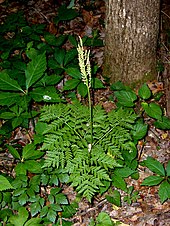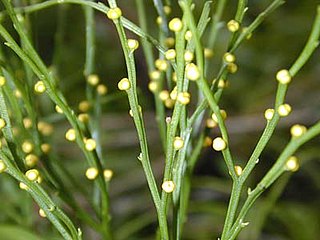
The ferns are a group of vascular plants that reproduce via spores and have neither seeds nor flowers. They differ from mosses by being vascular, i.e., having specialized tissues that conduct water and nutrients and in having life cycles in which the branched sporophyte is the dominant phase.
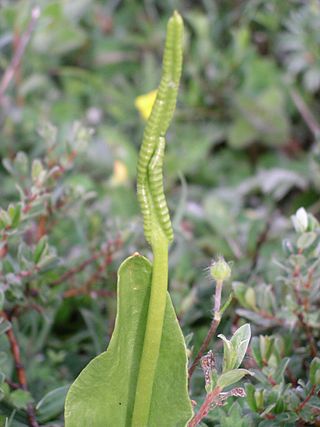
Ophioglossum, the adder's-tongue ferns, is a genus of about 50 species of ferns in the family Ophioglossaceae. The name Ophioglossum comes from the Greek meaning "snake-tongue". Their cosmopolitan distribution is mainly in tropical and subtropical habitats.

Anemia is a genus of ferns. It is the only genus in the family Anemiaceae in the Pteridophyte Phylogeny Group classification of 2016. Alternatively, the genus may be placed as the only genus in the subfamily Anemioideae of a more broadly defined family Schizaeaceae, the family placement used in Plants of the World Online as of November 2019. Its species are sometimes called flowering ferns, but this term is more commonly applied to ferns of the genus Osmunda. Fronds are dimorphic; in fertile fronds, the two lowermost pinnae are highly modified to bear the sporangia.
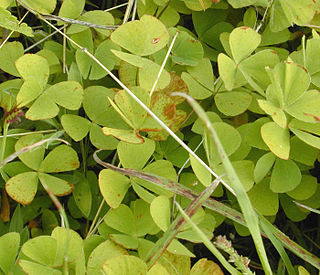
The order Salviniales is an order of ferns in the class Polypodiopsida.

Marattiaceae is the only family of extant (living) ferns in the order Marattiales. In the Pteridophyte Phylogeny Group classification of 2016, Marattiales is the only order in the subclass Marattiidae. The family has six genera and about 110 species. Many are different in appearance from other ferns, having large fronds and fleshy rootstocks.

A pteridophyte is a vascular plant that disperses spores. Because pteridophytes produce neither flowers nor seeds, they are sometimes referred to as "cryptogams", meaning that their means of reproduction is hidden.

Psilotaceae is a family of ferns consisting of two genera, Psilotum and Tmesipteris with about a dozen species. It is the only family in the order Psilotales.

Blechnaceae is a family of ferns in the order Polypodiales, with a cosmopolitan distribution. Its status as a family and the number of genera included have both varied considerably. In the Pteridophyte Phylogeny Group classification of 2016, the family has 24 genera, and excludes genera placed in the separate family Onocleaceae. The family is divided into three subfamilies, including Blechnoideae s.s. Alternatively, the entire family may be treated as the subfamily Blechnoideae s.l. of a very broadly defined family Aspleniaceae, and include genera others place in Onocleaceae.
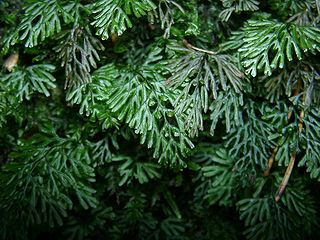
The Hymenophyllaceae, the filmy ferns and bristle ferns, are a family of two to nine genera and about 650 known species of ferns, with a subcosmopolitan distribution, but generally restricted to very damp places or to locations where they are wetted by spray from waterfalls or springs. A recent fossil find shows that ferns of Hymenophyllaceae have existed since at least the Upper Triassic.

Eusporangiate ferns are vascular spore plants, whose sporangia arise from several epidermal cells and not from a single cell as in leptosporangiate ferns. Typically these ferns have reduced root systems and sporangia that produce large amounts of spores.
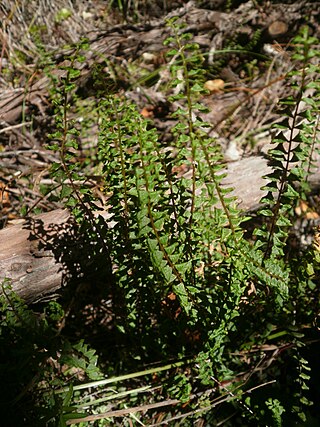
Lindsaeaceae is a pantropical family of ferns in the order Polypodiales. It contains six or seven genera with about 220 known species, some of which also extend into the more temperate regions of eastern Asia, New Zealand, and South America.

Saccolomataceae is a family of ferns in the order Polypodiales with about 19 species. It has been formerly treated as part of the Dennstaedtiaceae, however it has been classified as its own family according to Smith et al. (2006) The genus Saccoloma has been classified to include Orthiopteris, but the phylogeny of the group not yet fully understood. The family includes a dozen known species.

Sceptridium multifidum is a fern species in the Ophioglossaceae, known by the common names leathery grapefern and leathery moonwort.
Cheiroglossa palmata, synonyms Ophioderma palmatum and Ophioglossum palmatum, variously known as hand fern, dwarf staghorn, or hand tongue, is an epiphytic or terrestrial fern. As an epiphyte it grows in old leaf bases of the cabbage palmetto.

Sceptridium dissectum is a common fern in the family Ophioglossaceae, occurring in eastern North America. Like other plants in this group, it normally only sends up one frond per year. It has long been the subject of confusion because the frond presents in one of two forms, either the normal form that resembles other plants in the genus, or the skeletonized form.

Tectariaceae is a family of leptosporangiate ferns in the order Polypodiales. In the Pteridophyte Phylogeny Group classification of 2016 (PPG I), the family is placed in the suborder Polypodiineae. Alternatively, it may be treated as the subfamily Tectarioideae of a very broadly defined family Polypodiaceae sensu lato. The family comprises seven genera, of which Tectaria is by far the largest.

Polypodioideae is a subfamily belonging to the fern family Polypodiaceae, which is a member of the suborder Polypodiineae in the Pteridophyte Phylogeny Group classification of 2016 (PPG I). Alternatively, the subfamily may be treated as the tribe Polypodieae within a very broadly defined family Polypodiaceae sensu lato.

Ophioglossidae is one of the four subclasses of Polypodiopsida (ferns). This subclass consists of the ferns commonly known as whisk ferns, grape ferns, adder's-tongues and moonworts. It is equivalent to the class Psilotopsida in previous treatments, including Smith et al. (2006). The subclass contains two orders, Psilotales and Ophioglossales, whose relationship was only confirmed by molecular phylogenetic studies.
The Pteridophyte Phylogeny Group (PPG) is an informal international group of systematic botanists who collaborate to establish a consensus on the classification of pteridophytes that reflects knowledge about plant relationships discovered through phylogenetic studies. In 2016, the group published a classification for extant pteridophytes, termed "PPG I". The paper had 94 authors.


